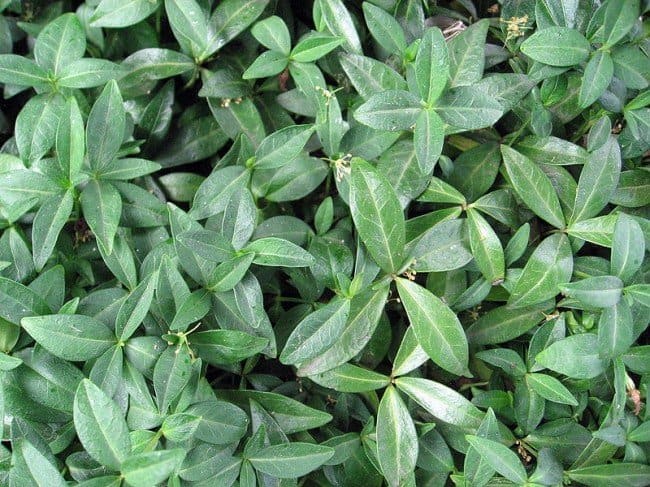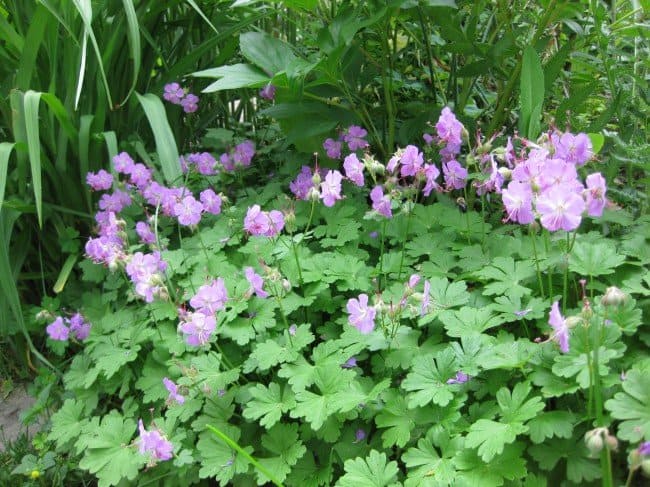
These autumn weeks of outdoor housekeeping tell the tale of seasonal progress — a few plants haven’t grown much, or worse, have declined from environmental stress or from competition for light with larger neighbours. But mostly I’m confronted with rampant growth, the end result of consistent cultivation on home ground. There are some weeks of heavy wood pruning ahead, but that can wait for colder weather.
This week I’m looking down at the ground, and finding my evergreen groundcovers need attention. In particular, there’s a roiling ocean of broadleaf evergreen periwinkle (Vinca minor, Zone 5; Zone 4 with snow cover) in the front garden, benefiting from good light and frequent irrigation. The shiny dark green leaves look terrific, but I noticed that my pink and green granite boulders (no laughter, please) have all but disappeared under the tide of periwinkle’s long slender tendrils. I’m certain it’s the right plant in the right place—it’s beautiful in four seasons, and suppresses weeds in the bed. But the lower stems are in shade and have dropped their leaves, causing the plants to rise up to 10 inches (25 cm) in height.
To renew the covering, I’ve begun cutting the mass back with secateurs, severing stems (leaving the rooted crowns in the ground) and rolling the mat of tangled runners forward like a giant snowball. I’ll spread a one-inch (2.5-cm) layer of composted manure over the periwinkle crowns to provide energy for renewal, but no other fertilizer because this vigorous plant doesn’t need it. In spring the crowns will sprout new stems and foliage, followed by lovely violet-blue flowers.
If you’ve got one of the silver-edged periwinkles, they’re less vigorous and you won’t likely see this rambunctious growth. Japanese spurge (Pachysandra terminalis, Zone 5) is another glossy broadleaf evergreen for sun or shade, and it seldom requires thinning. (The challenge more often is to thicken the plants into a dense mat.) Pachysandra will flop forward onto grass or pathways, and should be trimmed along its edges to keep it back.
Other evergreen groundcovers, such as cool shade-loving Russian arborvitae (Microbiota decussata, Zone 4) and the many low junipers for sunny locations, may show some bare patches on their woody branches, and this is a good time to cut them back conservatively by no more than one-quarter of their full length (to avoid looking butchered). If they’re too big for the area, remove and replace with a shorter-growing selection.
Geraniums make soft shoulders for hard places

If you’ve been following this blog, it comes as no surprise that I like rocks in all their colours, sizes and uses. But a rock is a hard place (now you may laugh!) and it’s improved with a soft shoulder for texture contrast.
There are all sorts of wonderful plants that will weep down upon, crawl up or encircle a landscape boulder to soften its massive form. However, for stone paths I like to see occasional edging (or even a continuous edge) of neat mound-shaped perennial plants under 12 inches (30 cm) in height, following along one or both sides to soften the hard surface and emphasize the design line of the pathway.
My curved stepping stone pathway has a casual border of perennial bigroot geranium ‘Bevan’s Variety’ (Geranium macrorrhizum ‘Bevan’s Variety, Zone 3) that’s charming with pink blooms and attractive in leaf all season. ‘Bevan’s Variety’ grows 10 inches tall and 18 inches wide (25 x 45 cm), and works well for informal paths.
Another geranium suitable for lining a formal stone path is ‘Max Frei’ (G. sanguineum ‘Max Frei’, Zone 4), a neat mound six to eight inches (15 to 20 cm) tall and wide, with magenta-pink flowers and red autumn foliage. In the same G. sanguineum group is deep magenta-purple ‘New Hampshire Purple’ (Zone 4), eight to 12 inches (20 to 30 cm) tall and wide; and also G. sanguineum var. lancastrense (Zone 4), blush-pink with crimson veins, another soft and low mound six to eight inches (15 to 20 cm) tall and wide.
There are lots of small mounding perennials that would be suitable for edging pathways, such as smaller selections of heucheras, certain small ferns and the dwarf form of lacy goat’s beard (Aruncus aethusifolius, Zone 3). Woodland walks in shade, formal walks in sun—there’s a soft shoulder for every hard place.
Still blooming in my garden: fuchsias and dahlias
Usually I plant tender ‘Gartenmeister’ fuchsia in containers, but this summer I put it directly in the ground where it overhangs a mat of European wild ginger (Asarum europaeum, Zone 3). The fuchsia has done surprisingly well and never once shown signs of wilt (I think it liked having roots in the cool soil). Combined with the shiny leaves of perennial ginger, they make a handsome duo still going strong at the end of October.
Oh dear, the dahlias are so big and beautiful, but frost is imminent and it’s time to take in the tubers. There will be an armload of flowers to trim off before lifting them; and I’ll rely on Karen York’s dahlia primer in the Fall issue of Garden Making to lead me through the process of storing the tubers over winter.
Thanks so much for being with me at Garden Making — always a pleasure to see you!

This is considered by horticulture organizations to be an invasive species.
Should only be used on big properties where there may be a hill and confined.